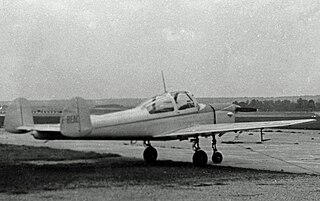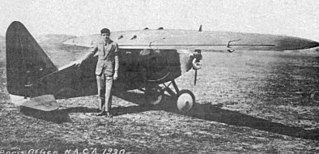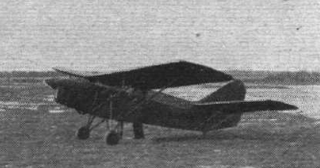
The Fouga CM.170 Magister is a 1950s French two-seat jet trainer aircraft that was developed and manufactured by French aircraft manufacturer Établissements Fouga & Cie. Easily recognizable by its V-tail, almost 1,000 have been built in France and under licence in West Germany, Israel, and Finland.

Morane-Saulnier MoS-50 was a French parasol configuration trainer aircraft built in 1924. The twin-seat aircraft was of wooden construction and was one of the last aircraft to have a rotary engine, a 97 kW (130 hp) Clerget 9B.

Constructions Aéronautiques Maurice Brochet was a French manufacturer of light aircraft established by Maurice Brochet in Neauphle-le-Château in 1947.

The Fouga CM.8 or Castel-Mauboussin CM.8 was a French sailplane of the 1950s, most notable in retrospect due to its place in the development of the Fouga CM.170 Magister jet trainer.

The Mauboussin M.120 was a trainer and touring aircraft built in France in the 1930s and again in the years following World War II.
Fouga was a French manufacturing company established by Gaston Fouga at Béziers during 1920. Originally specialising in the repair of railway rolling stock, the firm eventually became most noted for the aircraft it produced from its woodworking facilities at Aire-sur-l'Adour.

The Max Holste MH.52 was a 1940s French-built two-seat touring or training monoplane designed and constructed by Avions Max Holste.
The SNCAC Chardonneret were a short series of 1940s French three- and four-seat cabin monoplanes with the same wings and general layout but with different engines.

The Peyret-Mauboussin PM XI was a high-wing touring aircraft that was designed and produced by the French aircraft manufacturer Peyret-Mauboussin.
Peyret-Mauboussin was a French aircraft manufacturer of the late 1920s and early 1930s.

The Morane-Saulnier MS.755 Fleuret was a prototype French two-seat jet trainer designed and built by Morane-Saulnier. It failed to gain any orders but was developed into the larger four-seat MS.760 Paris.

The Morane-Saulnier MS.603 was a French-built two-seat light aircraft of the late 1940s.

The Rhein Flugzeugbau RW 3 Multoplan is a two-seat light pusher configuration aircraft that was produced in small numbers by Rhein Flugzeugbau GmbH between 1958 and 1961.

The Grinvalds Orion is one of the earliest (1981) composite kit- and homebuilt aircraft. A 2/4 seater with a single pusher engine, it was built in France and the United States in small numbers with several variations.

The Mauboussin M.40 Hémiptère was an experimental, single seat, single engine light aircraft with unequal span tandem wings, designed in France in the 1930s. Only one was built.

The Peyret-Mauboussin PM X, PM 4 or Mauboussin M.10 was a low power, single-seat, high wing cantilever monoplane. Only one was built but it set several records in the under 250 kg (550 lb) class both as a landplane and a floatplane.

The SFCA Taupin was a French tandem-wing aircraft, designed to provide a simple, stable and safe aircraft able to take-off and land in small spaces.

The Mauboussin M.112, M-12 or Mauboussin M.XII was originally called the Peyret-Mauboussin PM XII and was renamed when Mauboussin founded his own company in 1931, ending his partnership with Louis Peyret. It was a French, single-engine, two-seat, low cantilever wing touring monoplane. At least six were built.















